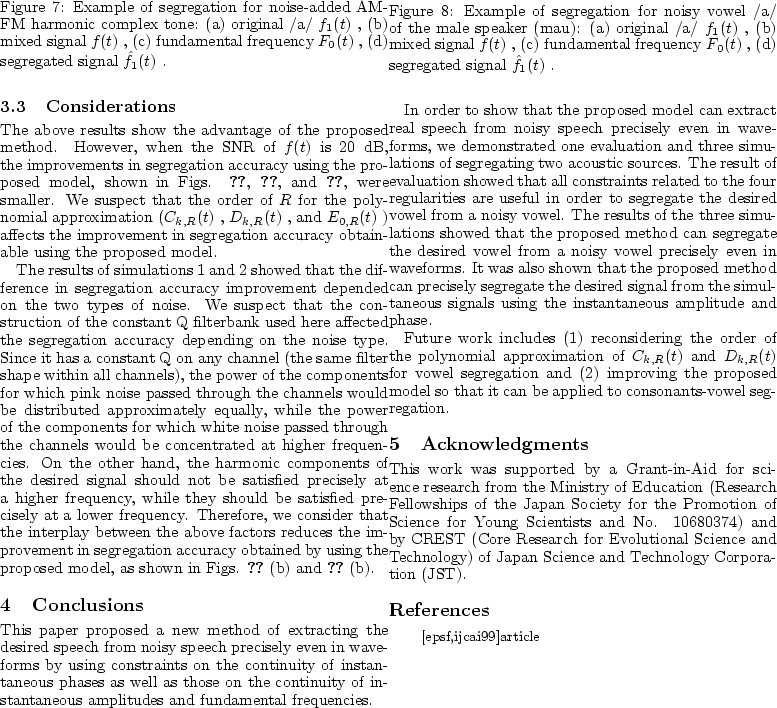The separation block determines Ak(t), Bk(t),
![]() ,
and
,
and
![]() from Sk(t) and
from Sk(t) and ![]() using constraints (ii) and (iv) in the determined concurrent time-frequency region.
In this paper, the improvement of the auditory sound segregation model is to reconsider the constraints on the continuity of
using constraints (ii) and (iv) in the determined concurrent time-frequency region.
In this paper, the improvement of the auditory sound segregation model is to reconsider the constraints on the continuity of
![]() as well as the constraints on the continuity of Ak(t) and F0(t).
Constraint (ii) is implemented such that
Ck,R(t) and
Dk,R(t) are linear (R=1) polynomials, in order to reduce the computational cost of estimating
Ck,R(t) and
Dk,R(t).
In this assumption, Ak(t) and
as well as the constraints on the continuity of Ak(t) and F0(t).
Constraint (ii) is implemented such that
Ck,R(t) and
Dk,R(t) are linear (R=1) polynomials, in order to reduce the computational cost of estimating
Ck,R(t) and
Dk,R(t).
In this assumption, Ak(t) and
![]() ,
which can be allowed to undergo a temporal change in region, constrain the second-order polynomials (
,
which can be allowed to undergo a temporal change in region, constrain the second-order polynomials (
![]() and
and
![]() ).
Then, substituting
dAk(t)/dt=Ck,R(t) into Eq. (
).
Then, substituting
dAk(t)/dt=Ck,R(t) into Eq. (![]() ), we get the linear differential equation of the input phase difference
), we get the linear differential equation of the input phase difference
 .
By solving this equation, a general solution is determined by
.
By solving this equation, a general solution is determined by
The signal flow of the separation block is shown in Fig. ![]() .
In the segment
Th-Th-1 that can be determined by
E0,R(t)=0, the terms Ak(t), Bk(t),
.
In the segment
Th-Th-1 that can be determined by
E0,R(t)=0, the terms Ak(t), Bk(t),
![]() ,
and
,
and
![]() are determined by the following steps.
First, the estimation regions,
are determined by the following steps.
First, the estimation regions,
![]() and
and
![]() ,
are determined by using the Kalman filter,
where
,
are determined by using the Kalman filter,
where
![]() and
and
![]() are the estimated values and Pk(t) and Qk(t) are the estimated errors (see Appendix A).
Next, the candidates of
Ck,1(t) at any
Dk,1(t) are selected by using the spline interpolation in the estimated error region (see Appendix B).
Then,
are the estimated values and Pk(t) and Qk(t) are the estimated errors (see Appendix A).
Next, the candidates of
Ck,1(t) at any
Dk,1(t) are selected by using the spline interpolation in the estimated error region (see Appendix B).
Then,
![]() is determined by using
is determined by using
| (16) |